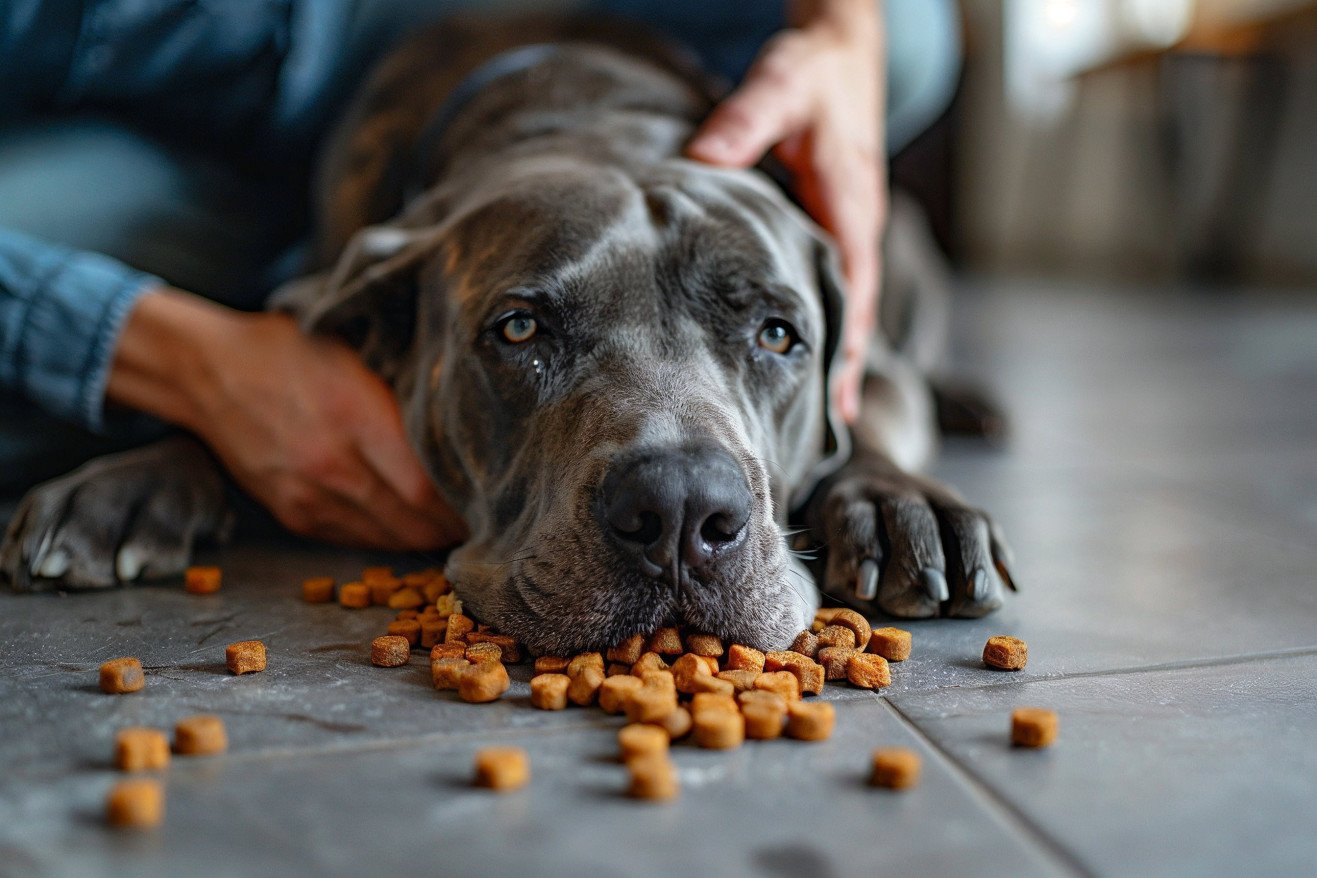Why Is My Dog Throwing Up Undigested Food Hours After Eating? Causes and Solutions
4 April 2024 • Updated 3 April 2024

If you've noticed your dog is throwing up undigested food a few hours after eating, you may be wondering what's going on. While the occasional episode of vomiting is normal, especially if your dog has eaten too quickly, if it happens regularly, it could be a sign of an underlying health problem. Some of the most common reasons for this type of vomiting include eating too fast, food sensitivities or allergies, gastrointestinal blockages, and more serious issues such as pancreatitis or inflammatory bowel disease.
To help you figure out what might be going on with your dog, we've rounded up the advice of veterinarians and the latest scientific research on digestive problems in dogs. From the most common causes to the research on how these issues are treated, this article will help you better understand what might be causing your dog to vomit undigested food and how you can help them feel better.
Why is my dog throwing up undigested food hours after eating?
Pancreatitis: A Severe Cause of Undigested Vomit in Dogs
Pancreatitis is a severe medical condition characterized by inflammation of the pancreas, which impairs the organ's ability to digest food and regulate blood sugar. VCA Animal Hospitals lists the most common clinical signs in dogs as nausea, vomiting, abdominal pain, fever, lethargy, diarrhea, and loss of appetite. In addition, dogs may exhibit a "praying" posture with their rear end in the air due to abdominal pain.
Pancreatitis is often diagnosed with blood work to look for elevated pancreatic enzymes, as described in WebMD's overview. The SPEC-CPL test is a rapid test that measures pancreatic lipase levels. Imaging studies such as ultrasound can also show inflammation in the pancreas, although the AKC explains that some cases can be subclinical and diagnosed based on clinical signs and history.
Treatment involves resting the pancreas by withholding food and water initially, administering pain relief, antibiotics if an infection is present, and fluid therapy to address dehydration from vomiting and diarrhea. As explained by the Merck Veterinary Manual, close monitoring and supportive care are important. Long-term dietary management may also be needed. Because it can be life-threatening, it's important to seek immediate veterinary care if you suspect your dog is vomiting undigested food due to pancreatitis.
Megaesophagus: When the Esophagus Can't Do Its Job
Megaesophagus is a condition in which the esophagus, the tube that connects the mouth to the stomach, becomes enlarged and loses its ability to move food down to the stomach, says VCA Animal Hospitals. This leads to the inability to swallow and digest food.
The most common sign of megaesophagus is regurgitation, which is different from vomiting. According to PetMD, regurgitation is a passive process in which food or liquid is expelled from the mouth without the retching or abdominal contractions that occur with vomiting. Dogs with megaesophagus may also experience excessive drooling, difficulty swallowing, and poor weight gain or weight loss due to the inability to get nutrients to the stomach.
Megaesophagus is often diagnosed with radiographic imaging, according to WebMD. X-rays can show the dilation of the esophagus, and a videofluoroscopic swallow study can be used to watch food and liquid move from the esophagus to the stomach. Other tests may be performed to rule out other causes.
Treatment for megaesophagus is focused on preventing regurgitation and aspiration pneumonia, a potentially life-threatening condition in which food or liquid is inhaled into the lungs. According to Hill's Pet Nutrition, treatment options include elevating food and water dishes, changing the consistency of food, feeding smaller, more frequent meals, and in severe cases, using feeding tubes or even surgery. It's important to continually watch for signs of aspiration pneumonia.
Dietary Factors and Food Intolerances
In addition to eating too quickly, eating non-food items can also cause dogs to vomit undigested food. According to Sundays for Dogs, eating too fast can cause digestive upset, which can lead to indigestion, vomiting, and even choking or aspiration.
Food intolerances or allergies can also cause digestive upset and vomiting, as the dog's body may not be able to properly digest certain ingredients. As pointed out by Vetnique Labs, food sensitivity may be the reason a dog is throwing up undigested food.
To help ensure your dog's digestive system is healthy, it's important to make sure they are eating a high-quality, well-balanced diet that is appropriate for their age, breed, and activity level. Bernie's Best suggests using slow-feeder bowls and feeding smaller, more frequent meals to help prevent dogs from eating too quickly and overeating. In addition, keeping human food and other potential hazards out of your dog's reach can help prevent them from eating something that could cause them to vomit.
By addressing dietary factors and potential food intolerances and making changes to the way you feed your dog, you can help improve your dog's digestive health and reduce the frequency of vomiting undigested food.
Other Causes and Risk Factors
Besides pancreatitis and megaesophagus, there are a number of other potential medical conditions that could be causing your dog to vomit undigested food. According to PetHelpful, inflammatory bowel disease, acid reflux, and gastrointestinal obstructions can all cause this issue. Stress or anxiety could also be a factor, as Vetnique Labs points out that higher cortisol levels can affect the digestive system.
It's also important to make sure that there aren't any parasitic or other infectious diseases that could be contributing to digestive problems, as the Metropolitan Veterinary Associates article mentioned. A vet will need to do a full examination and diagnostic work to make sure that there isn't anything else going on. This could include blood tests, imaging like X-rays or ultrasounds, and potentially endoscopic procedures to look at the digestive system more closely, according to PetMD.
After a full workup, your vet will be able to determine the cause and come up with a treatment plan that will help your dog's digestive system get back to normal. It's also helpful to keep track of any changes in your dog's behavior or symptoms, as this can help the vet during the diagnostic process.
When to See a Vet
While an occasional episode of vomiting may not be a cause for concern, if your dog is throwing up undigested food on a regular basis, it is important to see a vet. According to PetHonesty, some signs that you should take your dog to the vet right away include vomiting more than once, an inability to keep food or water down, signs of dehydration, lethargy, or any other symptoms that worry you.
If left untreated, frequent vomiting can lead to complications like dehydration, imbalances in electrolytes, and weight loss, according to Sundays for Dogs. Pet parents should make sure to keep a log of their dog's vomiting, including how often it is occurring, when it is happening, and any changes in behavior or potential triggers.
It is important to seek medical care as soon as possible to ensure that your dog is properly diagnosed and treated before the issue leads to further complications. According to Metropolitan Veterinary Associates, a dog should be brought to the emergency room if they are unable to be cared for at home, which includes vomiting repeatedly and an inability to keep food or water down. Seeking medical care as soon as possible can help ensure that the issue is properly diagnosed and that your dog's digestive health is restored.
Conclusion: How to Help Your Dog's Digestive Health
The most important thing to remember when it comes to your dog's digestive health is that there are several reasons why they may be vomiting undigested food. These include eating too quickly, food intolerances or allergies, serious conditions like pancreatitis or megaesophagus, and other underlying gastrointestinal issues.
However, no matter what the cause, it's important to remember that early intervention and an accurate diagnosis are key to helping your dog. Pet parents should also make sure to stay on top of their dog's eating habits, digestive health, and any other symptoms that may be cause for concern. By doing so, you can make sure that you're treating the issue at its source and helping your dog feel better.
In the end, the best way to help your dog's digestive health and prevent future bouts of vomiting undigested food is to make sure that you're prioritizing your dog's health and well-being and seeking out professional help when necessary. With the right treatment and care, you can make sure that your dog is as healthy and happy as possible.


